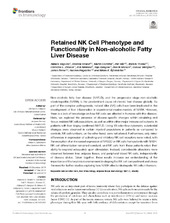| dc.contributor.author | Stiglund, Natalie | en_US |
| dc.contributor.author | Strand, Kristina | en_US |
| dc.contributor.author | Cornillet, Martin | en_US |
| dc.contributor.author | Stål, Per | en_US |
| dc.contributor.author | Thorell, Anders | en_US |
| dc.contributor.author | Zimmer, Christine L. | en_US |
| dc.contributor.author | Näslund, Erik | en_US |
| dc.contributor.author | Karlgren, Silja | en_US |
| dc.contributor.author | Nilsson, Henrik | en_US |
| dc.contributor.author | Mellgren, Gunnar | en_US |
| dc.contributor.author | Fernø, Johan | en_US |
| dc.contributor.author | Hagström, Hannes | en_US |
| dc.contributor.author | Björkström, Niklas K. | en_US |
| dc.date.accessioned | 2020-05-19T15:54:37Z | |
| dc.date.available | 2020-05-19T15:54:37Z | |
| dc.date.issued | 2019-06-04 | |
| dc.Published | Stiglund, Strand K, Cornillet M, Stål P, Thorell, Zimmer, Näslund E, Karlgren, Nilsson H, Mellgren G, Fernø J, Hagström H, Björkström NK. Retained NK cell phenotype and functionality in non-alcoholic fatty liver disease. Frontiers in Immunology. 2019;10:1255 | eng |
| dc.identifier.issn | 1664-3224 | |
| dc.identifier.uri | https://hdl.handle.net/1956/22307 | |
| dc.description.abstract | Non-alcoholic fatty liver disease (NAFLD), and the progressive stage non-alcoholic steatohepatitis (NASH), is the predominant cause of chronic liver disease globally. As part of the complex pathogenesis, natural killer (NK) cells have been implicated in the development of liver inflammation in experimental murine models of NASH. However, there is a lack of knowledge on how NK cells are affected in humans with this disease. Here, we explored the presence of disease-specific changes within circulating and tissue-resident NK cell populations, as well as within other major immune cell subsets, in patients with liver biopsy-confirmed NAFLD. Using 18-color-flow cytometry, substantial changes were observed in certain myeloid populations in patients as compared to controls. NK cell numbers, on the other hand, were not altered. Furthermore, only minor differences in expression of activating and inhibitory NK cell receptors were noted, with the exception of an increased expression of NKG2D on NK cells from patients with NASH. NK cell differentiation remained constant, and NK cells from these patients retain their ability to respond adequately upon stimulation. Instead, considerable alterations were observed between liver, adipose tissue, and peripheral blood NK cells, independently of disease status. Taken together, these results increase our understanding of the importance of the local microenvironment in shaping the NK cell compartment and stress the need for further studies exploring how NASH affects intrahepatic NK cells in humans. | en_US |
| dc.language.iso | eng | eng |
| dc.publisher | Frontiers | eng |
| dc.rights | Attribution CC BY | eng |
| dc.rights.uri | http://creativecommons.org/licenses/by/4.0/ | eng |
| dc.title | Retained NK cell phenotype and functionality in non-alcoholic fatty liver disease | en_US |
| dc.type | Peer reviewed | |
| dc.type | Journal article | |
| dc.date.updated | 2020-01-31T07:41:03Z | |
| dc.description.version | publishedVersion | en_US |
| dc.rights.holder | Copyright 2019 The Author(s) | |
| dc.identifier.doi | https://doi.org/10.3389/fimmu.2019.01255 | |
| dc.identifier.cristin | 1721050 | |
| dc.source.journal | Frontiers in Immunology | |

